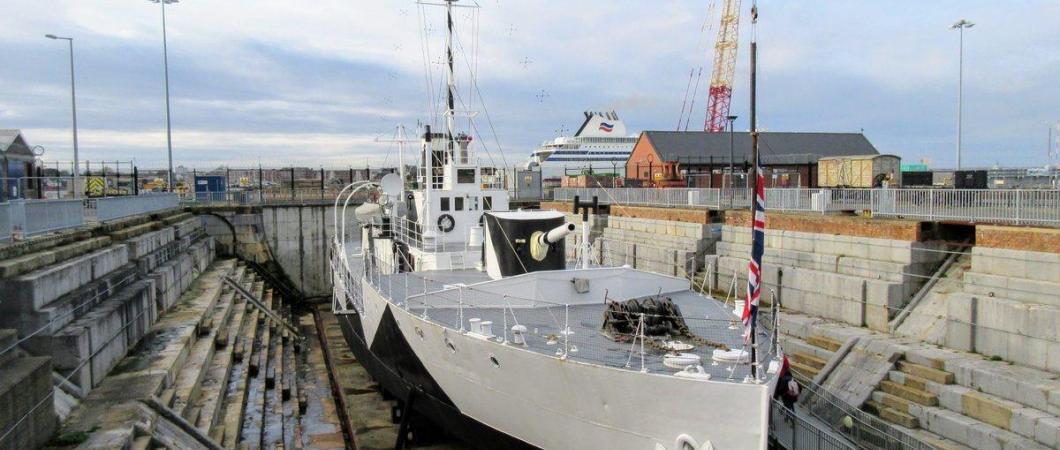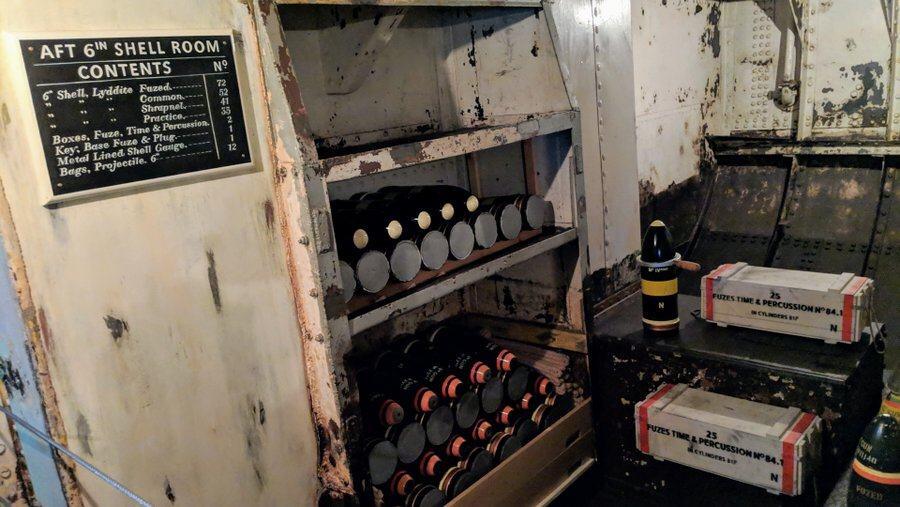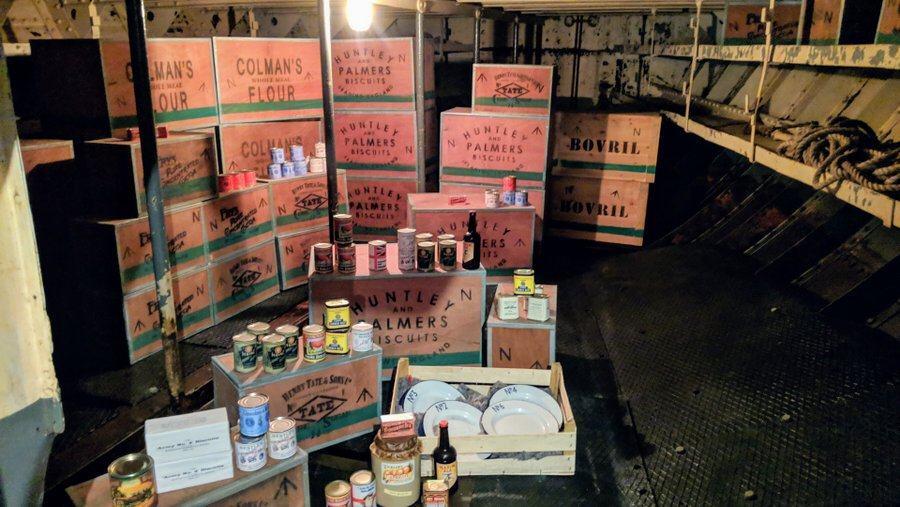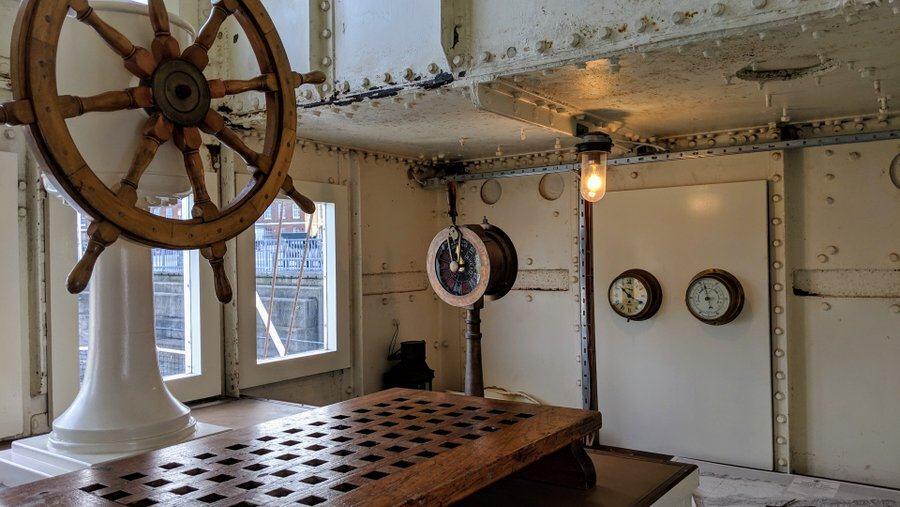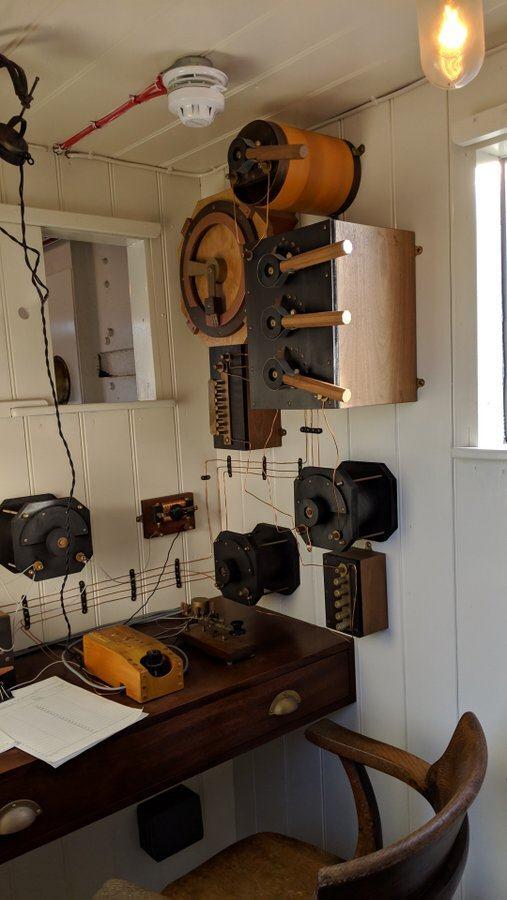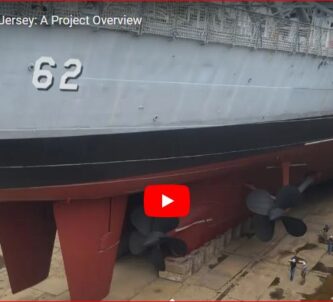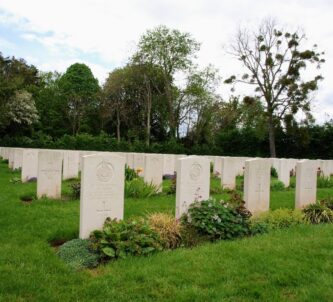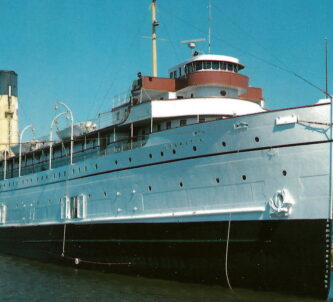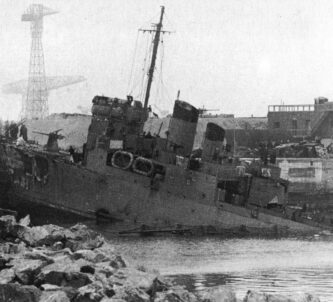HMS M33 is the smallest of the National Museum of the Royal Navy (NMRN)’s museum ships and you’ll find her in her dry dock next to HMS Victory.
She is significant because she is the last remaining ship from the Gallipoli campaign in WW1.
History
HMS M33 is a 580-ton M29-class monitor designed and built for shore bombardment with her two 6-inch naval guns. Her shallow draught allowed her to get close to the coast (a “littoral” ship¹), but reportedly made her roll like a pig in big seas offshore!
She was one of five monitors ordered in March 1915, only a year into WW1. Her construction at Workman Clark² shipyard, Belfast, was fast-tracked so she was launched just two months later in May and went into service with her crew of 67 men and five officers, in June.
Given her poor sea-going attributes, she was towed to her first operational area – the Dardanelles. By early August she was shelling in support of the IX Corps landing of 20,000 troops at Suvla Bay – a tactical landing in support of the Anzac troops’ failed attempt to seize the Sari Bair heights.
When the campaign was over HMS M33 stayed in the Mediterranean becoming a guardship at Salonika and Stavros. She returned to the UK in April 1919 and was decommissioned… but hastily re-commissioned a month later and dispatched to Russia to fight the Bolsheviks on the River Dvina.
Back in the UK she was turned into a mine-laying training ship in 1925 and then ended up being used variously as an office, a workshop, and a refuelling barge.
In 1984 she was sold to the Hartlepool Ship Preservation Trust in Hartlepool (now part of the National Museum of the Royal Navy. In 1990 she was returned to Portsmouth and prepared for display in her current dock.
HMS M33 the Museum Ship
NMRN has done a good job converting her for visitors. She has been restored to the way she would have been at Gallipoli, but in the dazzle camouflage paintwork of her Russian campaign.
Stairs or a lift (The access ramp and lift were installed to allow all visitors, including those using wheelchairs could access the ship.) take you to the bottom of the dock and you enter onto her lower decks through a door cut in her hull. She is pretty clear down below, with some displays recreating her stores and munitions magazine.
In WW2 (1943) her engine room and boilers were removed and she was towed to the Clyde to act as a boom defence floating workshop, so there’s plenty of space in the mid section of hull for interactive audio visual experiences to explain how the ship was operated and her role in the Gallipoli Campaign and the Russian Revolution.
There’s also a viewing platform so that visitors can see into the mess, which has been recreated as it was in 1915.
From here you can get topsides to the main, the foredeck and bridge – all much more interesting than below decks.
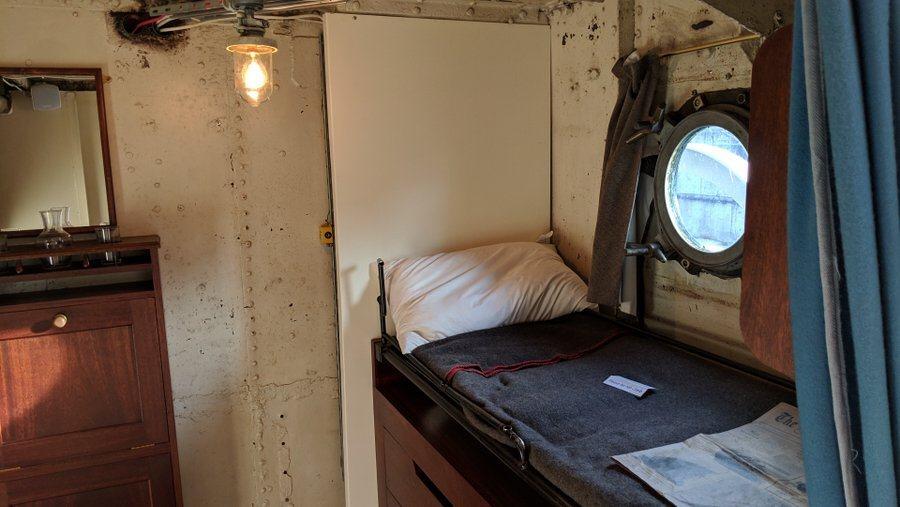
The aft gun is on the main deck, though I couldn’t get to it on my visit. Some of the officer cabins and galley, ward room, and heads (toilets) are on this level. They’ve been reconstructed as they would have been in 1915. The prop food in the galley looks almost edible and they use audio soundscapes to bring these parts of the ship to life.
The forward gun is on the focsle. The ship is designed around these guns and they are impressive. One of the reasons they were able to built her and her sister monitors so quickly was because they already had the guns and their mounts going spare. They had been originally intended for the five new Queen Elizabeth-class battleships but had become surplus to requirements.
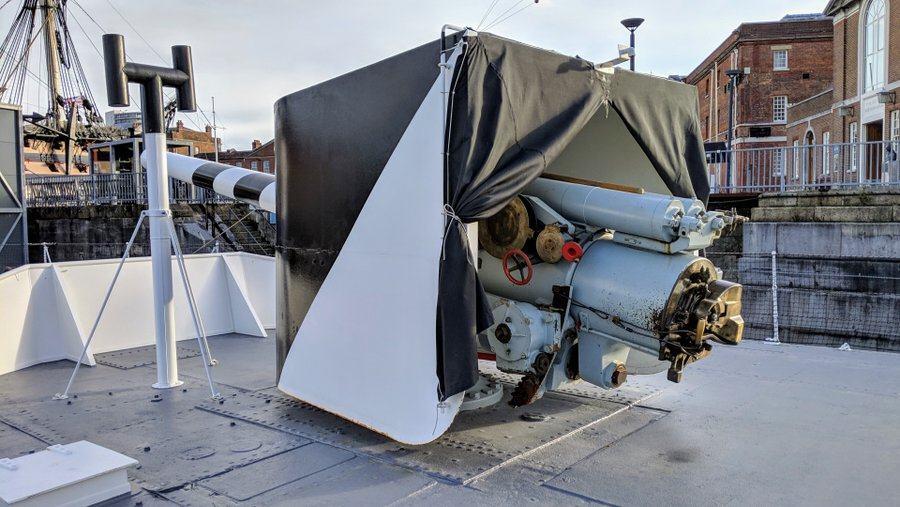
From the foredeck you can climb up to the navigation deck with the wheelhouse and behind it, the wireless room.
The odd thing about the wheelhouse is that wheel itself and engine room telegraph are mounted on a high plinth, whereas the chart table is at deck level. I’m guessing this was to improve the view from the steering position, so the helmsman could see better over the forward gun (unusually at that moment there was nobody around to ask).
Other Portsmouth Posts
| Portsmouth Historic Dockyard | HMS Victory & Nelson | HMS M33 |
| Mary Rose | Submarine Museum | Explosion! |
| HMS Warrior | D-Day Story | Visiting Portsmouth |
¹ “Littoral” is once again a buzzword in NATO Navy circles, particularly the US & UK navies.
² The M29 class was hurriedly designed by young Admiralty constructor Charles Lillicrap. M33 was to be built at Harland and Wolff, but the work was passed to the nearby Workman Clark shipyard Global Maritime History
Declaration: No need. I was visiting Portsmouth on my own. All entrance fees, accommodation, petrol, etc paid by me.
Factbox
HMS M33 is a National Museum of the Royal Navy ship, located in the Portsmouth Historic Dockyard.
Website:
National Museum of the Royal Navy
Portsmouth Historic Dockyard
Portsmouth Historic Dockyard is a brand of the National Museum of the Royal Navy (it used to be separate).
Getting there:
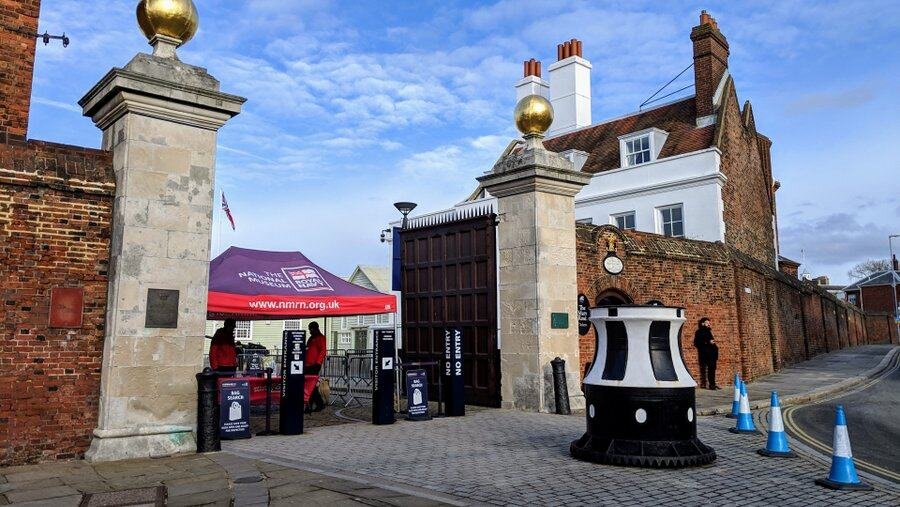
The Historic Dockyard is, naturally, right at the heart of Portsmouth. The entrance, Victory Gate, is at the junction where Queens St becomes The Hard, a hundred yards from Portsmouth Harbour rail station and the bus station.
If you are driving, you can make use of the Park + Ride scheme from the outskirts of Portsmouth, which of course is cheap as chips! (£4 per day). Or the Historic Dockyard has parking for 295 cars (follow the brown tourist signs) and within easy walking distance is the Gunwharf Quays shopping centre car park.
You can get between the NMRN sites at the historic Dockyard and across the harbour using the free NMRN passenger ferry.
Entry Price:
The Portsmouth Historic Dockyard tickets cover almost all attractions in the dockyard and on the other side of the port, namely HMS Warrior, HMS Victory, Boathouse 4, Harbour Tours, Action Stations, HMS M.33, National Museum of the Royal Navy Portsmouth, Dockyard Apprentice, Explosion Museum and Royal Navy Submarine Museum. The Mary Rose is a separate ticket.
| Any 1 Attraction* | Any 2 Attractions | Any 3 Attractions | Full Navy | |
|---|---|---|---|---|
| Adult | £18.00 | £25.00 | £32.00 | £31.00 |
| Child (5-15) | £13.00 | £18.00 | £23.00 | £18.50 |
| Concession (60+ or Students) | £17.00 | £23.50 | £30.00 | £27.00 |
| Family 1+3 (1 adult & up to 3 children) | £37.60 | – | – | £48.00 |
| Family 2+3 (2 adults & up to 3 children) | £49.60 | – | – | £68.00 |
* Explosion Museum and Royal Navy Submarine Museum count as one attraction for ticketing purposes.
You can see, the pricing is designed to steer visitors to “Full Navy” tickets, which give access to all the attractions on site (except Mini Ports, Laser Quest and Mary Rose) and the other side of the harbour, for a whole year.
However you might also consider NMRN Membership, which gives you a year’s access to all these attractions AND to the Fleet Air Arm Museum in Yeovilton, Somerset, HMS Trincomalee in Hartlepool, and HMS Caroline in Belfast. You also get 25% discount for up to 4 friends & family members, and discounts on NMRN food outlets & shops. You also get their ‘Scuttlebut magazine, which actually a seriously good read! Membership costs £48.00 Single, £66.00 Couple, £78.00 Family.
Look out for Special Offers online. Eg. currently there’s a ’14 months for 12′ deal on Full Navy tickets.
There is a Gift Aid option on tickets (which allows the NMRN to reclaim 25p tax for every £1 spent).
Opening Hours:
The Historic Dockyard is open on all days around the year (apart from the usual December breaks), but the two sites on the other side of the harbour have different timings. In particular, Explosion! only opens on weekends during the winter.
During the rest of the year it is open every day (inc Sundays and public holidays), except Tuesday mornings.
Portsmouth Historic Dockyard
| WINTER (29 Oct 2018 – 25 Mar 2019) | SUMMER (26 Mar 2019 – 28 Oct 2019) |
|---|---|
| 10am to 5pm Daily | 10am to 5:30pm Daily |
Submarine Museum, Gosport and Explosion!, Priddy’s Hard.
| WINTER (29 Oct 2018 – 31 Mar 2019)** | SUMMER (01 Apr 2019 – 27 Oct 2019) | |
|---|---|---|
| Submarine Museum | 10:30am*** – 4:30pm. Closed every Monday and Tuesday. | 10.00am – 5.00pm Daily |
| Explosion | 10:30am*** – 4.30pm. Closed Mon – Fri. Open Sat & Sun. | 10.00am – 5.00pm |
** This excludes February half term (18 – 22 Feb) when both sites will be open every day.
*** I would double check on this. When I arrived at 10.30am I was told Explosion! had been open for 30 mins and the website was in error.

